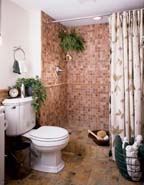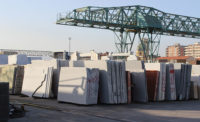
Have you ever had someone tell you that you cannot use stone in wet areas? It simply is not suitable? It is too slippery? It may be too hard to maintain? Frankly, these are fallacies and issues that can be overcome.
In today's construction marketplace, stone is a design material that should indeed be specified for use in wet areas. The objection that stone is not suitable for wet areas, simply does not apply. You can find stone with all types of surface treatments that make it appropriate for use in wet areas. Stone is readily available in thermal finishes (with a rough surface texture) and honed finishes (a dull surface finish that is not highly polished). These finishes are ideal for the “walking†surfaces in wet areas, as they are not slippery at all. In addition, you can still use the polished surfaces of the same material for all vertical applications, wet or dry.
Another stumbling block may be that the stone darkens when wet, and one can see shadowy spots on the face of the stone. This objection is easily overcome by following good installation practices. If the stone is fully bedded in accordance with industry standards such as ANSI and NATC requirements, the dark spots should not be an issue.


